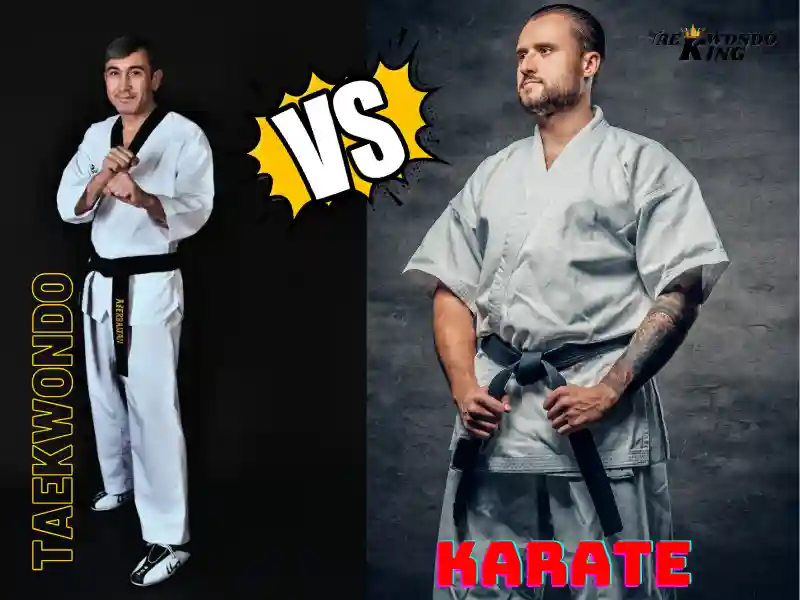
Karate and Taekwondo are both popular martial arts that can be effective for self-defense. However, they have different philosophies and techniques that may make one more suitable for certain situations than the other. Karate and Taekwondo are both popular martial arts that can be used for self-defense. However, when it comes to choosing which one is better for self-defense, there are a few factors to consider.
In the realm of martial arts, Karate and Taekwondo stand out as two of the most popular and widely practiced disciplines. Both offer a rich history, a strong emphasis on striking techniques, and a focus on personal development. However, when it comes to self-defense, which martial art is better suited to protect you in real-world situations?
To answer this question comprehensively, let’s delve into the unique attributes of Karate and Taekwondo, exploring their techniques, training methodologies, and how they apply to self-defense scenarios.
Overview of Karate and Taekwondo
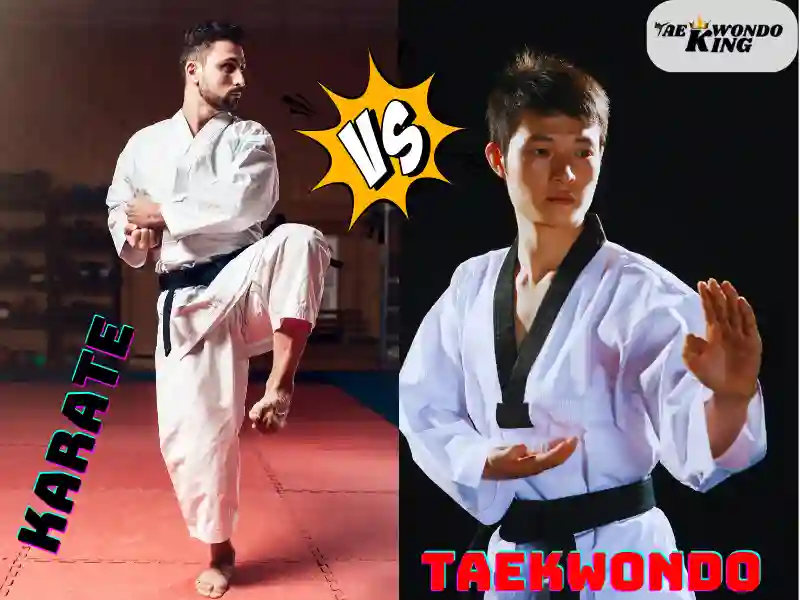
Karate and Taekwondo are both martial arts that originated in Asia and have gained popularity worldwide. Karate originated in Okinawa, Japan, while Taekwondo originated in Korea. Both martial arts focus on self-defense techniques and physical fitness, but they have distinct differences in their techniques and philosophies.
Karate emphasizes striking techniques, such as kicks, blocks, punches, strikes, and elbow strikes. It also includes various blocks, throws, and joint locks. The practice of Karate involves katas, which are choreographed patterns of movements, and kumite, which is sparring with an opponent. Karate practitioners also focus on developing mental discipline, respect, and self-control.
On the other hand, Taekwondo is known for its high, fast kicks and jumping and spinning kicks. It also includes punches, strikes, and blocks, but the emphasis is on using the legs for powerful and agile movements. Taekwondo practitioners train in forms called poomsae, which consist of a series of movements performed in a specific order. Sparring in Taekwondo focuses on scoring points by landing kicks and punches on the opponent.
In terms of competition, both martial arts have their own set of rules and regulations. Karate competitions often involve point sparring, where competitors aim to score points by striking certain target areas. Taekwondo competitions include both point sparring and Olympic-style sparring, where athletes wear protective gear and aim to score points by landing kicks and punches.
While Karate and Taekwondo have their differences, they share the common goal of physical and mental development. Both martial arts offer a way to improve fitness, build confidence, and learn self-defense techniques. Whether one chooses Karate or Taekwondo, practicing these martial arts can be a rewarding and challenging journey.
Similarities between Karate and Taekwondo
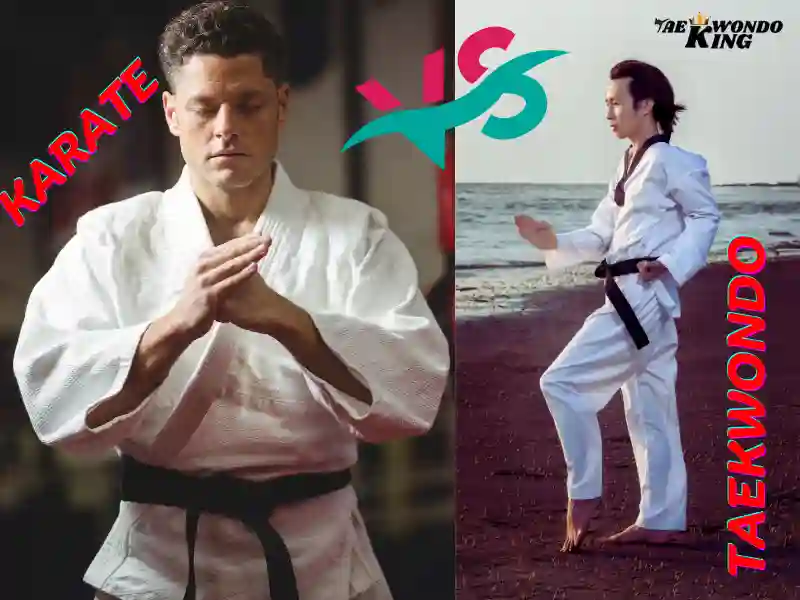
Karate and Taekwondo are two popular martial arts that share many similarities. Both disciplines emphasize discipline, physical fitness, and the development of self-defense skills. In terms of techniques, both Karate and Taekwondo involve striking and kicking techniques. However, there are some differences in the execution and emphasis of these techniques. Karate focuses more on hand strikes and close-range combat, while Taekwondo places a greater emphasis on high, fast, and powerful kicks.
Another similarity between Karate and Taekwondo is the training and belt system. Both martial arts use colored belts to indicate the progress and skill level of practitioners. The belt system provides a clear path for students to progress through different ranks and levels of expertise.
Both Karate and Taekwondo places a strong emphasis on discipline, respect, and self-control. Practitioners of both martial arts are expected to adhere to a code of conduct and display good fair play. Karate and Taekwondo, such as the emphasis on hand strikes versus kicks, also share many similarities in terms of techniques, training, and values. Both martial arts provide practitioners with an opportunity for physical fitness, self-defense skills, and personal growth.
Differences between Karate and Taekwondo self-defense
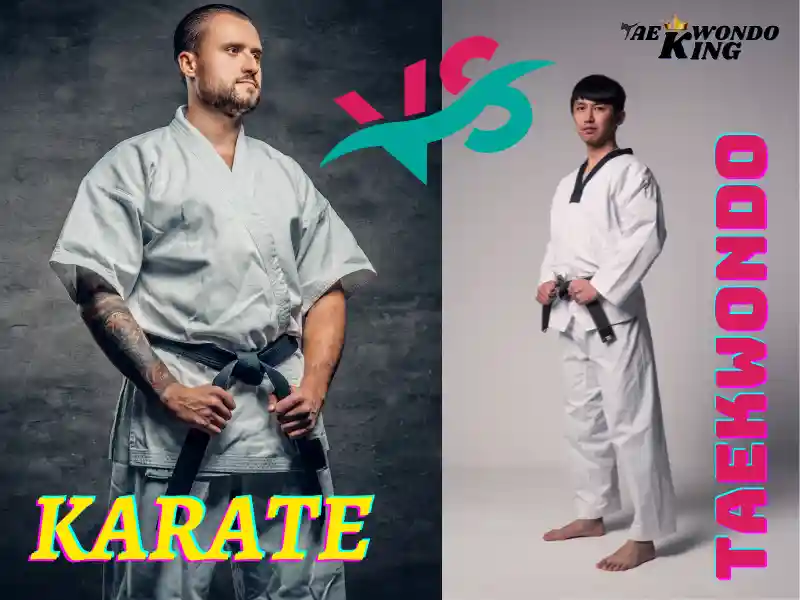
Karate and Taekwondo are both popular martial arts that focus on self-defense techniques. While they have similarities, they also have distinct differences in their approaches to self-defense. In Karate, the emphasis is on striking techniques using punches, kicks, and knee strikes. The goal is to quickly disable an opponent by targeting vital areas of their body.
On the other hand, Taekwondo places a greater emphasis on high, fast kicks and jumping and spinning kicks. It is known for its flashy and acrobatic techniques. Additionally, Taekwondo incorporates more footwork and agility, allowing practitioners to swiftly evade attacks and create openings for counterattacks.
Another significant difference is the use of forms or patterns. Karate utilizes katas, which are pre-arranged sequences of movements, to practice techniques and develop muscle memory. In contrast, Taekwondo uses poomsae, similar to katas but emphasizing fast and powerful kicks. Ultimately, both Karate and Taekwondo provide effective self-defense techniques, but they differ in their focus and execution.
Training Methods of Karate and Taekwondo
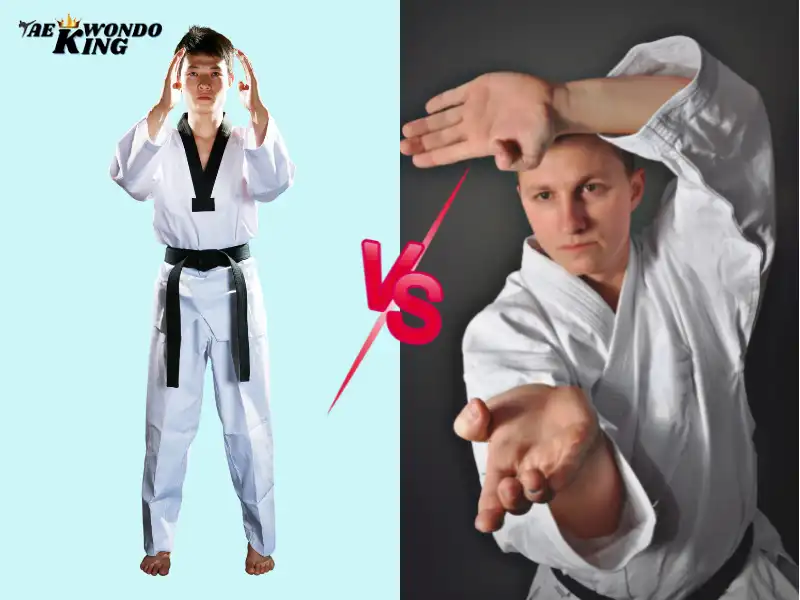
Karate and taekwondo are both martial arts that require discipline and physical training. However, there are some key differences in their training methods. In karate, emphasis is placed on developing strong punches and kicks through repetitive practice of kata, which are predetermined sequences of movements. This helps to build strength, accuracy, and control.
Taekwondo focuses more on high kicks and fast movements. Taekwondo practitioners often engage in sparring sessions to practice their techniques in a competitive setting. This helps to improve their speed, agility, and reaction time. Additionally, taekwondo training often includes breaking boards or tiles to demonstrate power and precision. Overall, while both karate and taekwondo involve physical conditioning and technique development, their training methods differ in terms of the specific skills they prioritize and the training exercises they utilize.
Practicality and Real-Life Applications
Karate and Taekwondo are both martial arts that have gained popularity all over the world. While they may seem similar, there are significant differences between the practicality and real-life applications of these two disciplines.
Karate focuses on strong punches, kicks, and strikes, with an emphasis on overpowering opponents through sheer force. It emphasizes techniques that can be used in close-quarters combat, making it a practical self-defense system. In real-life situations, karate practitioners are trained to quickly neutralize threats and disable attackers.
Taekwondo places a greater emphasis on high, fast kicks and jumping and spinning kicks. It is known for its flashy and acrobatic techniques, making it more suited for competitive sparring. While Taekwondo can still be used for self-defense, its emphasis on kicks may not always be practical in real-life situations, where there may be obstacles or the need for quick, close-range strikes.
In addition, Taekwondo emphasizes discipline, respect, and self-control, which are important values in martial arts training. It focuses on developing mental and physical strength, as well as improving flexibility and agility. Karate, too, emphasizes discipline and respect, but its focus is more on physical strength and power.
Mental Discipline and Confidence
Karate and Taekwondo are both martial arts that require mental discipline and confidence. However, there are some differences between the two when it comes to these aspects. In Karate, mental discipline is emphasized through the practice of katas, which are predetermined sequences of movements. These katas require focus, concentration, and precision, which developmental discipline.
Taekwondo places more emphasis on confidence. The high kicks and fast movements in Taekwondo require a strong sense of self-assurance and belief in one’s abilities. Confidence is also built through sparring sessions, where practitioners are encouraged to face opponents and showcase their skills. Therefore, while both Karate and Taekwondo cultivate mental discipline and confidence, the approaches and focuses differ between the two.
Physical Fitness and Conditioning
Physical fitness and conditioning are both important aspects of martial arts training, but there are some key differences between the two when it comes to karate and taekwondo. In karate, physical fitness focuses on overall strength, flexibility, and endurance. Practitioners engage in various exercises and drills to improve their cardiovascular fitness, muscular strength, and flexibility.
On the other hand, conditioning in karate specifically targets the muscles and movements used in karate techniques. This involves repetitive practice of strikes, kicks, blocks, and stances to develop muscle memory and improve technique execution. In taekwondo, physical fitness also includes strength, flexibility, and endurance, but it places more emphasis on explosive power and agility.
Taekwondo practitioners engage in high-intensity workouts and plyometric exercises to improve their kicking speed and power. Conditioning in taekwondo focuses on specific kicking techniques and combinations, with drills and sparring sessions designed to enhance speed, accuracy, and timing. While both physical fitness and conditioning are important in both karate and taekwondo, the specific training methods and goals may vary based on the martial arts’s techniques and principles.
Taekwondo vs. Karate? Which is Better for Self-Defense?
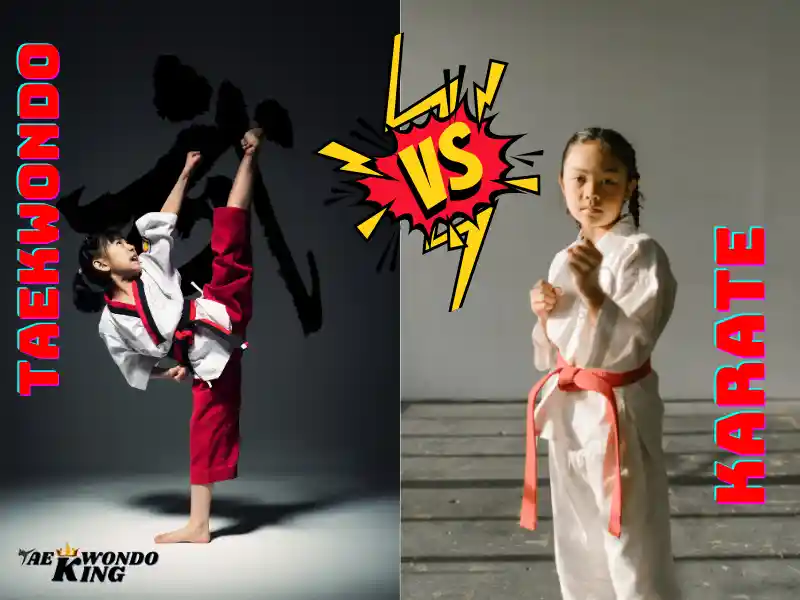
Whether karate or Taekwondo is better for self-defense depends on various factors, including personal preferences, training goals, and the specific self-defense scenarios one anticipates. Here are some considerations:
Personal Preferences:
Do you prefer striking with your hands and a balance of kicks (Karate) or are you more comfortable relying on high kicks and dynamic footwork (Taekwondo)?
Training Goals:
Are you interested in competition and sport, or is your primary focus on practical self-defense? Taekwondo’s sports emphasis can be an advantage if you enjoy competition.
Physical Attributes:
Consider your body type and physical abilities. Taekwondo’s emphasis on speed and agility may be advantageous for individuals with these attributes, while Karate’s balanced approach may suit a wider range of body types.
School and Instructor:
The quality of the school and instructor can significantly impact your training experience in either martial arts. A well-rounded school may incorporate aspects of both Karate and Taekwondo into their curriculum.
Realism in Training:
Whichever martial art you choose, it’s crucial to ensure that your training includes realistic self-defense scenarios and pressure testing to prepare you for real-life situations.
Can Karate defeat Taekwondo?
In a confrontation between a practitioner of Karate and one of Taekwondo, victory is not solely determined by the martial art practiced. Success depends on the individual’s skill, strategy, and adaptability in a given situation. Both Karate and Taekwondo offer effective techniques for self-defense and combat scenarios.
How to achieve a black belt in Karate?
To achieve a black belt in karate, you will need to follow these steps:
1. Find a reputable karate school or dojo and enroll in classes. Make sure the instructors are qualified and experienced.
2. Attend classes regularly and practice consistently. Dedication and discipline are key to progressing in karate.
3. Learn and master the basic techniques, forms (katas), and self-defense techniques taught in your karate style.
4. Progress through the ranks by earning different colored belts. Each belt represents a certain level of skill and knowledge.
5. Set clear goals and work towards them. Develop a training plan and focus on improving your technique, strength, flexibility, and stamina.
6. Take part in tournaments and competitions to gain experience and test your skills against other practitioners.
7. Study the philosophy and principles of karate, including its moral code and values. Karate is not just about physical strength but also about mental and spiritual development.
8. Show respect and humility towards your instructors and fellow students. Martial arts is also about personal growth and character development.
9. Complete the required training hours and demonstrate proficiency in all aspects of karate to qualify for a black belt test.
10. Finally, pass the black belt test, which usually involves demonstrating your skills, knowledge, and character. The requirements may vary depending on the style and organization.
Remember, achieving a black belt in karate is a long-term commitment and requires dedication, perseverance, and hard work.
How to achieve a black belt in Taekwondo?
To achieve a black belt in Taekwondo, you will need to follow a structured training program and meet certain requirements set by your Taekwondo school or organization. Here are some general steps that are typically involved:
1. Start by enrolling in a reputable Taekwondo school or club and attend regular classes. It is important to find a qualified instructor who can guide you through the process.
2. Progress through the different color belt ranks by learning and mastering the required techniques, forms (poomsae), sparring, self-defense, and breaking techniques. Each belt level has its specific requirements, which you will need to fulfill.
3. Practice regularly and consistently. Dedication, discipline, and hard work are essential to progress in Taekwondo. Attend classes, practice at home, and participate in additional training opportunities such as seminars and workshops.
4. As you approach the higher belt levels, the requirements and standards become more challenging. You will need to demonstrate a higher level of skill, knowledge, and understanding of Taekwondo principles.
5. Prepare for and pass the necessary examinations or tests conducted by your Taekwondo school or organization to advance to the next belt level. These tests typically involve showcasing your proficiency in different aspects of Taekwondo, including techniques, forms, sparring, and breaking.
6. Aim for consistency and continuous improvement. Becoming a black belt in Taekwondo is not just about passing a test but also about embodying the principles of Taekwondo in your daily life. Show respect, discipline, perseverance, and humility both on and off the training mat.
Remember that the journey towards a black belt is a long-term commitment and requires patience, dedication, and a strong work ethic. It is important to set realistic goals and enjoy the process of learning and growing in Taekwondo.
How to achieve a high rank in Taekwondo?
To achieve a high rank in taekwondo, you should focus on several key areas:
1. Training: Regular and disciplined training is essential. Attend classes consistently, practice at home, and work on improving your technique, strength, flexibility, and speed.
2. Set goals: Set specific and achievable goals for yourself. Break down your training into smaller milestones and work towards them. Regularly assess your progress and adjust your goals accordingly.
3. Listen to your instructors: Pay close attention to your instructors and follow their guidance. They have the knowledge and experience to help you progress in taekwondo. Ask questions, seek feedback, and apply their advice in your training.
4. Consistency and dedication: Consistency is key in taekwondo. Stay committed to your training, even when it gets challenging. Regular practice and dedication will help you improve steadily over time.
5. Compete and participate: Participating in competitions and events can help you gain experience, test your skills, and showcase your abilities. Take advantage of these opportunities to challenge yourself and learn from other practitioners.
6. Mental and physical fitness: Develop a strong mental attitude and discipline. Maintain a healthy lifestyle, including proper nutrition, adequate rest, and regular exercise. Mental and physical fitness play a significant role in achieving a high rank in taekwondo.
Remember, progress in taekwondo takes time and effort. Stay focused, and motivated, and continue to push yourself to reach your goals.
How to achieve success in Martial Arts?
To achieve success in martial arts, it is important to set specific goals and consistently work towards them. Here are some tips:
1. Find a reputable instructor or martial arts school that aligns with your goals and values.
2. Practice regularly and be consistent in your training. Regular practice will help improve your skills and build muscle memory.
3. Stay motivated and disciplined. Martial arts require dedication and discipline to progress.
4. Focus on technique and form. Mastering proper technique is crucial for advancement.
5. Push yourself and step out of your comfort zone. Challenge yourself to improve and learn new techniques.
6. Have a positive mindset and believe in your abilities. Mental strength is just as important as physical strength in martial arts.
7. Surround yourself with supportive and like-minded individuals who can push you to be your best.
8. Embrace failure and learn from your mistakes. Setbacks are a part of the learning process.
9. Stay committed and patient. Progress in martial arts takes time and effort.
10. Lastly, enjoy the journey and have fun! Martial arts is not just about achieving success, but also about personal growth and self-discovery.
How to achieve balance in Karate or Taekwondo?
Achieving balance in karate or taekwondo requires practice and focus. Here are some tips:
1. Strengthen your core muscles: A strong core helps maintain balance. Incorporate exercises like planks, sit-ups, and Russian twists into your training routine.
2. Proper posture: Maintain an upright posture with your shoulders back and your weight evenly distributed between both feet.
3. Practice stances: Stances are the foundation of martial arts. Spend time perfecting your stances, such as the front stance, horse stance, or cat stance, as they promote stability and balance.
4. Slow and controlled movements: Practice techniques slowly and with control. This allows you to focus on your balance and correct any flaws in your form.
5. Focus on your center of gravity: Be aware of your center of gravity and make sure it remains balanced and centered during movements.
6. Train on uneven surfaces: Practicing on surfaces like sand or grass can challenge your balance and improve your overall stability.
7. Visualization techniques: Visualize yourself being balanced and stable during your training. This mental practice can help improve your physical balance.
Remember, achieving balance in martial arts takes time and consistent practice. Don’t get discouraged and keep working on it.
How to achieve self-discipline in Martial Arts?
To achieve self-discipline in martial arts, you can follow these steps:
1. Set clear goals: Define what you want to achieve in your martial arts practice and set specific, measurable goals.
2. Create a routine: Develop a consistent training schedule and stick to it. Regular practice will help you develop self-discipline.
3. Stay motivated: Find ways to stay motivated, such as setting rewards for reaching milestones or finding a training partner who can hold you accountable.
4. Practice mindfulness: Cultivate mindfulness and focus during your training sessions. This will help you stay disciplined and present in the moment.
5. Embrace challenges: Push yourself outside of your comfort zone and embrace challenges. This will help you develop mental strength and discipline.
6. Develop a positive mindset: Cultivate a positive mindset and believe in your ability to achieve your goals. Positive self-talk and visualization techniques can help develop self-discipline.
7. Seek guidance: Find a qualified instructor or mentor who can provide guidance and support in your martial arts journey. They can help you stay disciplined and provide valuable feedback.
Remember, self-discipline takes time and effort to develop, so be patient with yourself and stay committed to your martial arts practice.
Is Taekwondo easier than Karate?
Both Taekwondo and Karate present unique challenges and require dedication and discipline to master. It’s not a matter of one being easier than the other, but rather a matter of personal preference and individual strengths. Some may find Taekwondo easier due to its emphasis on kicks and agility, while others may find Karate easier due to its focus on strength and precision. Ultimately, the difficulty of either martial art depends on the individual and their commitment to learning and practicing the techniques.
Karate vs Taekwondo, which is better for child
Both karate and taekwondo offer unique benefits for children. Karate focuses on striking, while taekwondo emphasizes kicking techniques. Karate promotes discipline, focus, and self-defense skills, while taekwondo emphasizes agility, flexibility, and speed.
The best martial arts for a child depends on their individual interests, goals, and learning style. It may be beneficial for a child to try both and see which one they enjoy and excel in the most. Both karate and taekwondo can provide valuable physical and mental development for children.
What is better for kids Karate or Tae Kwon Do?
Karate and Tae Kwon Do are both great martial arts options for kids. Karate focuses on strong, fast movements and includes punching, kicking, and blocking techniques, while Tae Kwon Do emphasizes high, fast, and spinning kicks, as well as jumping and fast kicking techniques.
Both promote discipline, respect, and self-confidence, but the choice between the two depends on the child’s interests and goals. Trying a class in each can help them decide which one they enjoy and feel most comfortable with. Overall, both Karate and Tae Kwon Do can benefit kids in terms of physical fitness, self-defense skills, and personal development.
Which is better for girls Taekwondo or Karate?
The best martial art for a girl ultimately depends on her personal preferences and goals. Both Taekwondo and Karate have their own unique techniques and training methods. Taekwondo focuses more on kicking techniques and agility, while Karate emphasizes striking and blocking techniques.
Some girls may prefer the discipline and focus of Taekwondo, while others may prefer the strength and power of Karate. Girls need to try both and see which martial arts suits them best based on their interests and abilities. Ultimately, the best choice is the one that the individual enjoys and feels comfortable with.
Is it good for kids to learn Taekwondo?
Learning Taekwondo can be very beneficial for kids. It teaches important values like discipline, respect, and self-control. It also helps improve physical fitness, coordination, and strength. Taekwondo can boost self-confidence and teach kids how to defend themselves. It’s also a fun and engaging way for kids to stay active and learn new skills. Overall, Taekwondo can be a positive and beneficial activity for kids to participate in.
Can a kid get a black belt in TKD?
Yes, children can earn a black belt in Taekwondo. It requires dedication, hard work, and perseverance to reach the level of a black belt, regardless of age. Many martial arts schools have specific programs and guidelines for children to progress through the belt ranks, and with the right training and commitment, a child can achieve a black belt in Taekwondo. Kids need to have the support and guidance of their instructors and parents to reach this level of accomplishment.
Why is Taekwondo more popular than Karate?
There are several reasons why Taekwondo might be more popular than Karate. Taekwondo places a strong emphasis on kicking techniques, which can be more visually exciting to watch. It is also an Olympic sport, which has increased its visibility and appeal. Additionally, Taekwondo schools often prioritize discipline and self-control, which can be attractive to parents seeking a martial art for their children. In contrast, Karate focuses on both striking and grappling techniques, which may not be as visually appealing to some. Ultimately, the popularity of martial arts can vary by region and culture, so it’s important to consider the specific factors that contribute to the popularity of Taekwondo compared to Karate.
Is Karate or Tae Kwon Do better?
The best martial art for you will depend on your personal preferences and goals. Both Karate and Tae Kwon Do have their unique techniques and philosophies. Karate focuses on powerful, linear strikes and kicks, while Tae Kwon Do emphasizes dynamic, high-flying kicks and fast, agile movements. In Karate, you will learn to defend yourself with powerful, precise strikes, while Tae Kwon Do emphasizes flexibility and quick, explosive movements. It’s important to try both and see which one resonates with you more.
How did Taekwondo become popular?
Taekwondo has gained popularity for several reasons. Its effectiveness as a self-defense martial art, emphasis on discipline and physical fitness, and inclusion in the Olympic Games have all contributed to its widespread appeal.
Additionally, promotion through movies and media has also increased interest in the sport. The focus on mental and physical discipline, as well as the opportunity for personal growth and achievement, has attracted many individuals to practice Taekwondo. Overall, the combination of self-defense skills, physical fitness, and mental discipline has made Taekwondo a popular martial art around the world.
Why is Karate better than other sports?
Karate provides a range of physical and mental benefits that set it apart from other sports. It emphasizes self-defense, discipline, and self-control, essential skills for personal development. Additionally, karate helps improve strength, flexibility, and coordination, making it a well-rounded sport for overall fitness. Its focus on respect for others and continuous self-improvement makes it unique among many other sports.
What are the benefits of practicing Taekwondo?
There are many benefits to practicing Taekwondo, such as improved physical fitness, enhanced self-discipline, increased self-confidence, and the development of self-defense skills. Additionally, Taekwondo can also help improve focus, concentration, and mental discipline, making it a well-rounded martial art for both physical and mental well-being.
Is it easy to learn Taekwondo?
Learning Taekwondo can be challenging, but with dedication and practice, it is possible to master the techniques. Taekwondo requires discipline, patience, and physical fitness, but the rewards of learning this martial art are well worth the effort. With the right mindset and a good instructor, anyone can learn and excel in Taekwondo.
Is Taekwondo a hard sport?
Yes, learning and mastering Taekwondo can be quite challenging. It involves building physical strength, flexibility, and mental discipline. Practitioners need to commit to regular training and practice to become proficient in the techniques and forms of Taekwondo. However, many people find the challenges rewarding and fulfilling with dedication and perseverance.
In conclusion,
Both karate and Taekwondo have their strengths and weaknesses when it comes to self-defense. The best choice depends on your individual goals, physical attributes, and the quality of instruction available. Ultimately, the effectiveness of self-defense relies on the practitioner’s skill, adaptability, and ability to apply their training in real-world situations.
FAQ
Does Taekwondo help in a real fight?
Taekwondo training can aid in a real fight by instilling physical fitness, agility, and confidence. Effective self-defense in a real-world scenario requires practical application of techniques, adaptability, and situational awareness, all of which can be developed through Taekwondo practice when supplemented with realistic training scenarios and self-defense drills.
Can Karate be used for self-defense?
Yes, Karate can be used for self-defense. It teaches techniques for striking, blocking, and evading attackers. However, effectiveness depends on factors like the practitioner’s skill level, situational awareness, and adaptability. Practical application and realistic training scenarios enhance Karate’s utility in real-life self-defense situations.
Which one is better Judo or Karate?
The superiority of Judo or Karate depends on individual preferences, goals, and situations. Judo focuses on throws, grappling, and ground fighting, suitable for close-quarters combat and self-defense. Karate emphasizes strikes, blocks, and kicks, more applicable for stand-up fighting and self-defense from a distance. Both have distinct benefits and applications.
What is the opposite of Karate?
The opposite of Karate, a striking martial art, would be a grappling or throwing-based martial art such as Judo or Brazilian Jiu-Jitsu. While Karate emphasizes striking techniques like punches and kicks, these grappling arts focus on throws, joint locks, and ground fighting techniques for subduing opponents.
Is a red belt better than a black in Judo?
In Judo, a black belt typically signifies a higher level of proficiency and mastery compared to a red belt. Red belts are often awarded to highly esteemed practitioners who have made significant contributions to the art but are not considered higher in rank than black belts in terms of skill and expertise.
Is Judo the toughest sport?
Judo is considered one of the toughest sports due to its physical and mental demands. It requires strength, agility, timing, and technique. Competitors engage in intense grappling, throwing, and groundwork, testing their endurance and resilience. However, the perception of toughness can vary depending on individual experiences and perspectives.
What is better Judo or Kung fu?
The superiority of Judo or Kung Fu depends on individual preferences, goals, and context. Judo emphasizes throws, grappling, and ground fighting, suited for self-defense and competition. Kung Fu encompasses a diverse range of styles emphasizing striking, kicks, and forms, offering a holistic approach to martial arts training.
Is Judo effective in real life?
Yes, Judo can be highly effective in real-life situations. Its focus on throws, joint locks, and grappling techniques allows practitioners to control and neutralize opponents, making it applicable for self-defense. Practical training, adaptability, and situational awareness are crucial for maximizing Judo’s effectiveness in real-life encounters.
Why Judo is the best sport?
Judo is widely regarded as a top sport due to its ability to provide a complete workout, enhance flexibility and balance, and teach valuable self-defense techniques. The mental discipline and focus required in judo also contribute to its reputation as an outstanding sport for personal growth. Furthermore, judo’s popularity as an Olympic sport makes it even more appealing to athletes and fans.
Which is better Karate or Martial Arts?
Karate and martial arts both have their unique techniques and benefits, so which is better depends on what you are looking to achieve. Karate is a specific form of martial arts focusing on striking and defending against an opponent, while martial arts is a broader term that includes various disciplines, including karate. When choosing between the two, it’s important to consider your personal goals and preferences, as each offers different strengths and training methods.

Founder, Owner, and CEO of TaekwondoKing.
He is one of the top 100 martial artists in the World and among the top 20 referees in Bangladesh.
Ehatasamul Alom is an esteemed Kukkiwon Certified Taekwondo 3rd Dan Black Belt with over 15 years of experience in this dynamic martial art. Born in Rajshahi, Bangladesh, Ehatasamul’s journey with Taekwondo began at the tender age of seven. His passion led him to compete at national and international levels, where he has bagged numerous awards and honors. He is also a member of the Taekwondo National Referee Panel.
With a Bachelor’s degree in Sports Science from the prestigious Rajshahi University, Ehatasamul has a deep understanding of the technical and scientific aspects of martial arts and some other martial arts.
In 2022, Ehatasamul created the “TaekwondoKing.com” to share his knowledge, Free Resources, Values, and Real experiences. His articles focus on Taekwondo training techniques, competition strategies, Sport Products Reviews, and the art’s rich history and philosophy. He also writes about the importance of mental fortitude and discipline, key aspects of his teaching philosophy. He has already launched many sports, Taekwondo, and health-related Free online tools. His goal is to inspire both beginners and seasoned practitioners worldwide through insightful and engaging content.
If you need any help, contact Ehatasamul Alom at any time.


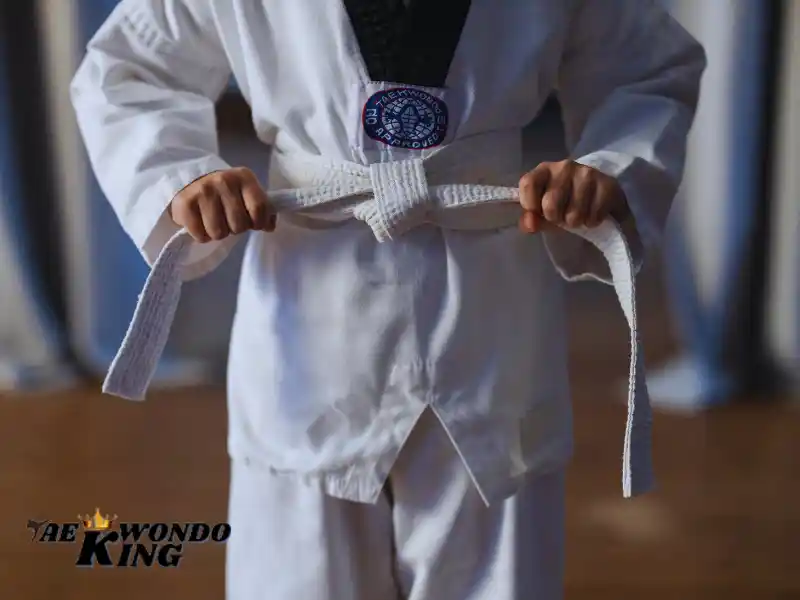


I appreciate how detailed and well-researched every post is. Thank you for your sharing. I am worried that I lack creative ideas. It is your article that makes me full of hope. Thank you. But, I have a question, can you help me?